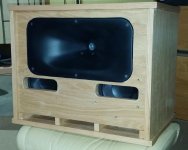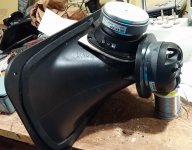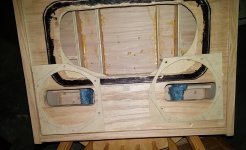Bill, I suspect that P.E. is preparing the way to carry the larger 44mm ( diaphragm sized driver ) by relieving itself of all inventory belonging to the 35mm ( sized driver ).
That ( sort of pre-emptive ) move would make sense if the final consumer cost isn't that great of an increase.
Power handling increases to 60 watts ( from 25 watts ) going to the 44mm size driver.
- One does need to consider the ( apparent ) fact that Tymphany aren't offering replacement diaphragms for these drivers ( effectively making them disposable items ).
( OTOH ), the smaller diaphragmed driver looks to be smoother in the FR ( according to the spec-sheets ) with a nicer impedance curve to boot.

That ( sort of pre-emptive ) move would make sense if the final consumer cost isn't that great of an increase.
Power handling increases to 60 watts ( from 25 watts ) going to the 44mm size driver.
- One does need to consider the ( apparent ) fact that Tymphany aren't offering replacement diaphragms for these drivers ( effectively making them disposable items ).
( OTOH ), the smaller diaphragmed driver looks to be smoother in the FR ( according to the spec-sheets ) with a nicer impedance curve to boot.
But then the 60W version is rated at 3dB lower sensitivity, so net output increase is ~0.8 dB? Who knows what is going on with Tymphany.... I wrote them (no reply so far). I also wrote Parts Express (answered online that the one I designed with is discontinued and a new version is to come out 'soon', but no word on what exactly or how soon). Pretty discouraging, particularly since in this design I was specifically wanting to use available, still in-production drivers so I'd have something someone could actually build if they wanted. I guess I could still go back to the Celestion CDX1-1445, which wasn't bad sounding (though had more measurable distortion).
Anyway, here is a photo of the shelf ported cabinet still with bare unfinished wood. I finally got around to mounting things into it temporarily to adjust the port length.
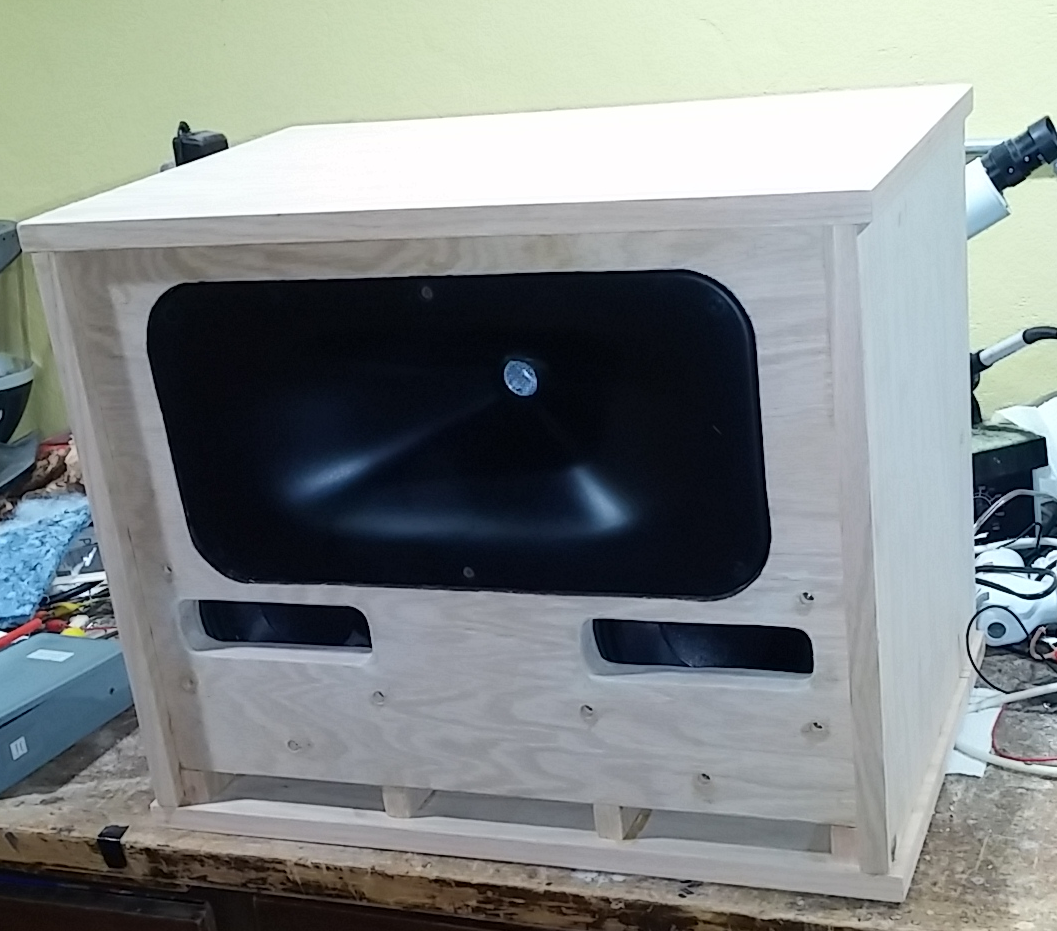
Anyway, here is a photo of the shelf ported cabinet still with bare unfinished wood. I finally got around to mounting things into it temporarily to adjust the port length.

Last edited:
How hard would it be to adapt it for the Celestion you're using in the other Synergy Horn you've made?
That CD is still available I think?
I bought me a pair of BMS neodymium CDs, but was a bit bummed when I took them apart and realized there's a 90 degree bend in the design, that can't be good for HOMs.
The Celestion might be the best option for under $100
That CD is still available I think?
I bought me a pair of BMS neodymium CDs, but was a bit bummed when I took them apart and realized there's a 90 degree bend in the design, that can't be good for HOMs.
The Celestion might be the best option for under $100
I was just looking at some of the crossover sims from earlier when I was using the Celestion still. It's not as smooth, and has a bit of a fight going down low enough, but not really bad.
It could be made to work, but it's hard to get enthused about taking all the driver design measurements again to get the delay exactly right, re-optimize for off-axis again, go outdoors for polars, all for something that won't be quite as good as what I already have. It's not like the world is falling all over itself to build up sets of these at the moment (only a few people have even heard them).
It could be made to work, but it's hard to get enthused about taking all the driver design measurements again to get the delay exactly right, re-optimize for off-axis again, go outdoors for polars, all for something that won't be quite as good as what I already have. It's not like the world is falling all over itself to build up sets of these at the moment (only a few people have even heard them).
That's really too bad about the CD. This is one I had bookmarked as something really cool I could actually construct (unlike other Synergy/Unity designs).
On a less depressing topic, are all of your measurements posted taken with the baffle recessed in the cabinet like that?
On a less depressing topic, are all of your measurements posted taken with the baffle recessed in the cabinet like that?
On a less depressing topic, are all of your measurements posted taken with the baffle recessed in the cabinet like that?
Yes, but it's only recessed 1/4" (6.3mm), for grille foam. The shadows make it look deeper than it is.
It's a concession of appearance (for domestic living room) over performance. But, realistically, the waveguide pretty much keeps high frequencies away from the edge, and 1/4" is too small to do much down below 800Hz where the waveguide is losing directivity.
We can hope the new Thymphany should be not too far in spec around the XOyou choosed... Best is too wait 
Do you need a compression because the BL ? Is a SB acoustic 96 db sensivity tweeter strong enough to loose not too much directivity in this horn ? One can be crossed at 1500 Hz iirc. and if the horn is adding a little spl, their aluminium tweeter dome can be crossed relativly low seing the Troels Gravsen curves ! Now does it match to a horn like the Seos 15 is an other story !
!
this compression is not too expensive here but duno in your country : http://www.toutlehautparleur.com/media/catalog/product/datasheet/beyma/CP380M-8.pdf : has certainly a sound signature not too far !
Do you need a compression because the BL ? Is a SB acoustic 96 db sensivity tweeter strong enough to loose not too much directivity in this horn ? One can be crossed at 1500 Hz iirc. and if the horn is adding a little spl, their aluminium tweeter dome can be crossed relativly low seing the Troels Gravsen curves ! Now does it match to a horn like the Seos 15 is an other story
this compression is not too expensive here but duno in your country : http://www.toutlehautparleur.com/media/catalog/product/datasheet/beyma/CP380M-8.pdf : has certainly a sound signature not too far !
That Beyma looks very nice on it's data sheet, but it is quite expensive here (about $180 each). Still, might be worth it if Tymphany doesn't get its act together (which would mean I'd never design with any of their drivers again!).
I'm also going to try some DIYSoundGroup DNA360 for this. They have very smooth response and go low, the only problem may be that the distance from the diaphragm to the exit is kind of long for use on a Synergy arrangement (it limits how high I can get the midrange to go).
I'm also going to try some DIYSoundGroup DNA360 for this. They have very smooth response and go low, the only problem may be that the distance from the diaphragm to the exit is kind of long for use on a Synergy arrangement (it limits how high I can get the midrange to go).
And this one : Dayton Audio D250P-8 1" Polyimide Compression Horn Driver ?
It had been already tested with sucess in a synergy design in the other synergy bar
It had been already tested with sucess in a synergy design in the other synergy bar
why did you finally choose the Thymphany ? Because about its warm sound signature which match ok with a direct cone woofer (your previous input) ?
I believe myself too much clearness can be a trap and should be only the result of a good source...(well : a good DAC, that's why I'm a little scared by active XO... while knowing all is about trade off)
I believe myself too much clearness can be a trap and should be only the result of a good source...(well : a good DAC, that's why I'm a little scared by active XO... while knowing all is about trade off)
More technical than that -- it has a nice low diaphragm resonance (under 800Hz), so its phase doesn't get wild if I cross it over low enough to smoothly reach the midrange (about 1400Hz). Easier crossover to do. Also. its high frequency response is very smooth, doesn't require adding LCR traps or the like to flatten its response.
Its sound signature was actually a little bright until I tilted the HF response down some, which often helps with these constant directivity setups since they would otherwise put more HF into the room than most speakers. Now it never seems to sound harsh. It sounds like one very, very, good driver, like a 'full range' wishes it could sound. Old 60's and 70's R&B music sounds unexpectedly wonderful on them, as does classical and world music. I think a response tilt would help with the Celestion, too (though that didn't seem so easy to accomplish when I was playing with crossover simulations the other day).
I actually considered for a bit going commercial with the design (I came to my senses). I think would be a better choice than what I hear in about 90% of the speakers in rooms I've heard.
Its sound signature was actually a little bright until I tilted the HF response down some, which often helps with these constant directivity setups since they would otherwise put more HF into the room than most speakers. Now it never seems to sound harsh. It sounds like one very, very, good driver, like a 'full range' wishes it could sound. Old 60's and 70's R&B music sounds unexpectedly wonderful on them, as does classical and world music. I think a response tilt would help with the Celestion, too (though that didn't seem so easy to accomplish when I was playing with crossover simulations the other day).
I actually considered for a bit going commercial with the design (I came to my senses). I think would be a better choice than what I hear in about 90% of the speakers in rooms I've heard.
Last edited:
I tried fiberglass.
It works for 6.5 woofers, but for 4" perhaps, its too risky.
The cone is too tiny, not gonna to survive the processes.
not sure if I posted this already, but I did something similar using aluminum foil and great stuff:
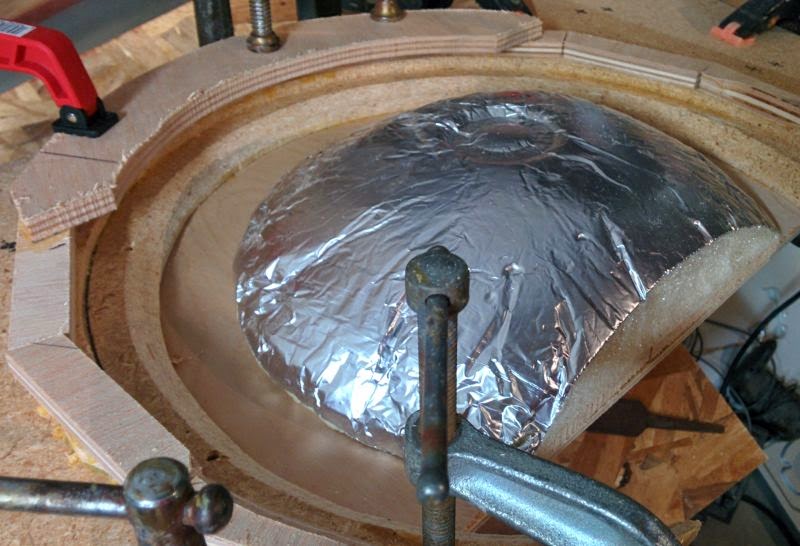
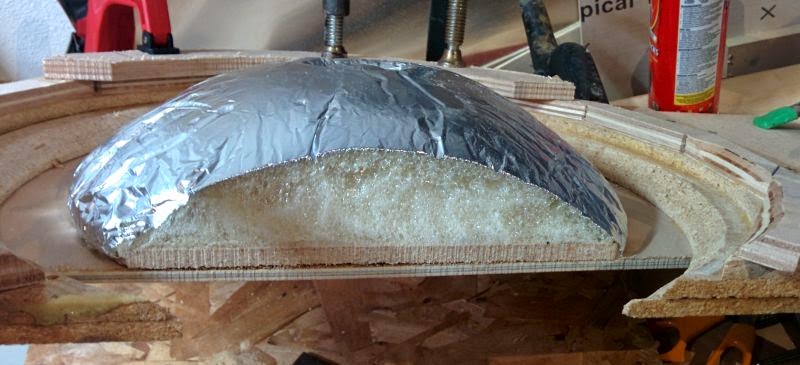
super easy to do - took about 30 minutes
Hi bwalso,
Thank you for sharing this design! I've been researching synergy horns for some months, and I appreciate the simplicity of your design (no table saw wizardry required) and aesthetic.
After volleying back and forth between a synergy or full-range horn design (BIB, Frugel horn XL, etc) for my living room, I've decided to pursue your plans due to the manageable cost and build, and homage to Danley. My DIY experience lies in the realm of live sound subwoofers (Cubo Sub, lilmike microwrecker), but I feel this would be a good first venture into hifi horns.
I went ahead and purchased a pair of the Peerless compression drivers.
Given the information on pages 10 and 12, I feel fairly confident in my ability to put these together, however some of the internals (bracing, mounting of the woofers as they seem to overlap the SEOS horn) remain a mystery to me. I have a few questions:
Could you provide some pictures of the inside of the cabinet, from the back? Has porting the cabinet proven worthwhile? Is the crossover in post #99 current?
Thanks!
Thank you for sharing this design! I've been researching synergy horns for some months, and I appreciate the simplicity of your design (no table saw wizardry required) and aesthetic.
After volleying back and forth between a synergy or full-range horn design (BIB, Frugel horn XL, etc) for my living room, I've decided to pursue your plans due to the manageable cost and build, and homage to Danley. My DIY experience lies in the realm of live sound subwoofers (Cubo Sub, lilmike microwrecker), but I feel this would be a good first venture into hifi horns.
I went ahead and purchased a pair of the Peerless compression drivers.
Given the information on pages 10 and 12, I feel fairly confident in my ability to put these together, however some of the internals (bracing, mounting of the woofers as they seem to overlap the SEOS horn) remain a mystery to me. I have a few questions:
Could you provide some pictures of the inside of the cabinet, from the back? Has porting the cabinet proven worthwhile? Is the crossover in post #99 current?
Thanks!
Hi sphykik,
I was going to hold off on posting details because of the Tymphany/Peerless driver fiasco, but since you were already able to get a pair of the drivers, here are some.
The crossover schematic in post 99 is current (for that driver). I haven't measured or listened to the ported version yet, just finally got the boxes coated with urethane and installed drivers and crossovers last night. The ported version is about double the volume of the sealed version, and looks much larger because it is so deep. The ported looks kind of neat with its vents, but I actually like the looks of the sealed one better (it is supposed to be "Small" Syns, after all). To have any bass with the sealed, though, you need either to add subs (which I see you already have) or use an equalizer for a Linkwitz Transform which I'm doing, and it works surprisingly well unless the special effects bass gets wild with home theater.
I have quite detailed drawings (attached) and some photos of the ported version, was going to go back and make similar drawings for the sealed (though I haven't yet). The sealed box is much simpler, though, not hard to figure out -- I just made a box and then added 2" high stiffeners so there were no unstiffened rectangles more than 7" on a side (leaving room for drivers of course). If I get the driver issue resolved (I have a pair of DNA360s on the way to try), I may still build another set of the sealed. Will probably use 'complex braces' for that, to make assembly a little more straight forward.
Note: the woofers mount through holes in the front panel, using bolts (either allen type mounted inset, or flat-head) and nuts -- make sure you drill the holes for the woofers after laminating the front panel and before gluing up the box. And make sure the wood screws that mount the horn aren't long enough to punch into the woofer cones.
Bill
I was going to hold off on posting details because of the Tymphany/Peerless driver fiasco, but since you were already able to get a pair of the drivers, here are some.
The crossover schematic in post 99 is current (for that driver). I haven't measured or listened to the ported version yet, just finally got the boxes coated with urethane and installed drivers and crossovers last night. The ported version is about double the volume of the sealed version, and looks much larger because it is so deep. The ported looks kind of neat with its vents, but I actually like the looks of the sealed one better (it is supposed to be "Small" Syns, after all). To have any bass with the sealed, though, you need either to add subs (which I see you already have) or use an equalizer for a Linkwitz Transform which I'm doing, and it works surprisingly well unless the special effects bass gets wild with home theater.
I have quite detailed drawings (attached) and some photos of the ported version, was going to go back and make similar drawings for the sealed (though I haven't yet). The sealed box is much simpler, though, not hard to figure out -- I just made a box and then added 2" high stiffeners so there were no unstiffened rectangles more than 7" on a side (leaving room for drivers of course). If I get the driver issue resolved (I have a pair of DNA360s on the way to try), I may still build another set of the sealed. Will probably use 'complex braces' for that, to make assembly a little more straight forward.
Note: the woofers mount through holes in the front panel, using bolts (either allen type mounted inset, or flat-head) and nuts -- make sure you drill the holes for the woofers after laminating the front panel and before gluing up the box. And make sure the wood screws that mount the horn aren't long enough to punch into the woofer cones.
Bill
Attachments
Attached is a better pdf of the build diagrams (apparently the pdf converter I used on the other isn't universally understood by all pdf readers).
Also, here is a photo showing the internal braces/stiffeners on the sealed version -- just some 1/2" x 2" plywood slats, cut to fit on the back panel and to the walls. I just trimmed them to size, put glue on them, and forced them into place (and laying various heavy tools down on them to hold them down while drying where it seemed necessary). That could be done in a more elegant way, though -- I just did that because the back panel seemed pretty resonant after I first made the boxes. I also wedged stiffeners to subdivide the top,bottom, and sides, but I don't know if those were really necessary. Make sure you leave room to be able to get your hands behind the woofers for putting the nuts onto their mounting screws.
You can also see where I stapled a sheet of cotton insulation and layed several layers of it over the braces behind the woofers, so they wedged between the woofers and the back panels. Also (not shown) I had several sheets behind the tweeter driver so it wedged between there and the back panel, to keep everything damped and quiet. In the ported boxes, I used those extensible felt furniture gliders, and those were a lot easier to adjust.
Also, here is a photo showing the internal braces/stiffeners on the sealed version -- just some 1/2" x 2" plywood slats, cut to fit on the back panel and to the walls. I just trimmed them to size, put glue on them, and forced them into place (and laying various heavy tools down on them to hold them down while drying where it seemed necessary). That could be done in a more elegant way, though -- I just did that because the back panel seemed pretty resonant after I first made the boxes. I also wedged stiffeners to subdivide the top,bottom, and sides, but I don't know if those were really necessary. Make sure you leave room to be able to get your hands behind the woofers for putting the nuts onto their mounting screws.
You can also see where I stapled a sheet of cotton insulation and layed several layers of it over the braces behind the woofers, so they wedged between the woofers and the back panels. Also (not shown) I had several sheets behind the tweeter driver so it wedged between there and the back panel, to keep everything damped and quiet. In the ported boxes, I used those extensible felt furniture gliders, and those were a lot easier to adjust.
Attachments
Last edited:
Thank you for taking the time to respond so thoroughly. The plans are very well done! Bracing makes sense, as does the layering of the sub-baffles. The extending furniture gliders support the magnets of the driver and woofers?
Last I sourced plywood around here, 5' x 5' birch was all I could find. I'll begin looking for 4' x 8', as that should be much easier (no translating, had to do that with the Cubos) and less expensive.
In the meantime, I'll stay tuned for your thoughts regarding the ported version. I will certainly run these with a sub so the un-ported version could work, but I'd prefer the ability to turn the sub off for some albums. That and I've never shied away from large speakers
Currently, searching for the driver on Parts Express directly leads to a message, "Sorry, but we could not find a direct match for this search," however Googling part-number "DFM-2535R00-08" yields a Parts Express link where the drivers are listed as in stock. Very odd. I certainly hope the current driver's availability continues, but interested buyers may want to act now.
Last I sourced plywood around here, 5' x 5' birch was all I could find. I'll begin looking for 4' x 8', as that should be much easier (no translating, had to do that with the Cubos) and less expensive.
In the meantime, I'll stay tuned for your thoughts regarding the ported version. I will certainly run these with a sub so the un-ported version could work, but I'd prefer the ability to turn the sub off for some albums. That and I've never shied away from large speakers
Currently, searching for the driver on Parts Express directly leads to a message, "Sorry, but we could not find a direct match for this search," however Googling part-number "DFM-2535R00-08" yields a Parts Express link where the drivers are listed as in stock. Very odd. I certainly hope the current driver's availability continues, but interested buyers may want to act now.
Last edited:
- Home
- Loudspeakers
- Multi-Way
- Small Syns
